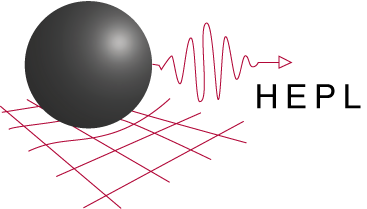News & Events
HEPL Seminar
Wednesday, February 28, 2007 11:00am
Location: Applied Physics 200
Paul Brink, Department of Physics, Stanford University
speaking for the (Super)CDMS collaboration
“Present status and future plans of the
Cryogenic Dark Matter Search (CDMS)”
Presently CDMS is part-way through the operation of the CDMS-II experiment, housed at the Soudan mine, Minnesota, and has released the most sensitive WIMP-nucleon cross-section exclusion limits to date. We report on the ongoing activites at Soudan, which include the operation of the full CDMS-II payload since mid-2006. The expected final reach of CDMS-II by the end of 2007 is a WIMP-nucleon cross-section sensitivity of 2.1 x10^-44 cm2, at a WIMP mass of 60 GeV/c2.
To proceed further, we have proposed the SuperCDMS program. In the first phases, each detector element is 2.5 times thicker than the CDMS-II crystals, thus allowing the more rapid deployment of a larger payload. The first phase we have recently proposed for funding is the Detector Project which will deploy the new detectors at the Soudan mine, followed by a 25~kg experiment which will need to be performed at a site deeper than Soudan in order not to be limited by a muon-induced neutron background and reach a desired goal of 1.3x10^-45 cm. These cross-sections, and approximate WIMP mass determinations from the kinematics of discovery events, are of interest and are complimentary to Supersymmetry investigations at the LHC and future linear colliders.
Dr. Paul L. Brink is a senior research scientist in the Stanford Physics Department engaged in the Cryogenic Dark Matter Search (CDMS) experiment. Dr. Brink served as chair of the collaboration's detector sub-system group to oversee the fabrication and testing of the athermal phonon detectors required for the CDMS-II experiment, and was also heavily involved in the commissioning of the experiment's cryogenic system sited at the Soudan mine, Minnesota. Dr Brink has also contributed to NASA projects for both developing X-ray detectors, of interest to survey the warm-hot intergalactic medium (WHIM) dark matter; and optical-photon photo-spectrometers optimized to study compact, rapidly time-varying sources.
Between 1997 and 1999 Dr. Brink developed superconductive instruments at Oxford Instruments, Cambridge U.K. Projects included X-ray detectors for material characterization, high-performance Superconducting Quantum Interference Devices (SQUIDs), a superconducting gravity gradiometer for mineralogical exploration, and a cyrogenic current comparator. Previously, Dr. Brink had participated as a Post-doc affiliate in the CDMS-I experiment performed on the Stanford campus in HEPL ES-III. Dr Brink received his MA degree and D. Phil from Oxford University, his thesis explored the interaction of X-ray photons in low-temperature superconductors.
Wednesday, February 28, 2007 11:00am
Location: Applied Physics 200
Join our HEPL Seminar Mailing list!
Send an email to majordomo@lists.stanford.edu and type
subscribe heplseminars user@stanford.edu
in the body of the message where user@stanford.edu is your email address
You will receive an email confirmation. We hope to see you at a HEPL Seminar soon.
Previous HEPL Seminars 2004, 2005, 2006, 2007:
Alfred Vogel
Institute of Biomedical Optics University of Lübeck, Germany
“New findings on plasma and cavity generation in aqueous media with fs and ns laser pulses, and their applications in cell surgery"
Thursday, January 25, 2007
Dr. Dan McCleese
Chief Scientist, Jet Propulsion Laboratory
“Recent Results and Future Direction of the Exploration of Mars"
Tuesday, September 26, 2006
Ned Wright
Professor of Physics and Astronomy, UCLA
What's New in Cosmology?
Thursday 9 March 2006
Peter Michelson
Stanford University
GLAST: The Gamma-ray Large Area Space Telescope Mission
Seminar and Tour
Thursday 16 Feb 2006
Robert L. Byer
Stanford University
"Acceleration of Electrons with Visible Light"
Wednesday 1 Feb 2006
Dr. Nicholas White
Chief,
Laboratory for High Astrophysics NASA Goddard Space Flight Center
“The NASA Beyond Einstein Program”
Wed 5 Oct 2005
Ulrich Schreiber, Forschungseinrichtung Satellitengeodäsie, TU-München
“High Precision Sagnac Interferometry for Applications in Geoscience ”
Thursday, September 8, 2005
Christopher D. Bass,
Indiana University / IUCF, “Measurement of the Parity-Odd Neutron Spin Rotation in Liquid-4He”
Monday, August 22, 2005
Anne Kinney, Director, Universe Division in the Science Mission Directorate, NASA, "Blue Planets, Black Holes"
Wednesday, 20 July 2005
Dr William Tobin, Department of Physics & Astronomy, University of Canterbury, New Zealand, "Foucault's Gyroscope of 1852"
Friday, 8 April 2005
Rex Geveden, NASA Chief Engineer, Independent Technical Authority
7 April 2005
Shooting the Moon: Probing Fundamental Gravity in the Solar System
Tom Murphy,
UC San Diego 3 March 2005
The GRACE Mission: Status and Science Results John Ries, Senior Research Scientist at the Center for Space Research at The University of Texas at Austin, 14 February 2005.
Hubble Robotic Servicing - Recent Engineering Development, Bill Reeve
Civil Space Director of Advanced Science Programs,
Lockheed Martin, 26 January 2005.
Interferometry for LISA, Daniel Shaddock, PhD, Interferometry Metrology and Optics Group, Jet Propulsion Laboratory, 17 November 2004.
The Large Synoptic Survey Telescope (LSST), Steve Kahn, Deputy Director, Kavli Institute for Particle Astrophysics and Cosmology, 27 October 2004.
HEPL-KIPAC Showcase. 29 September 2004. Agenda


